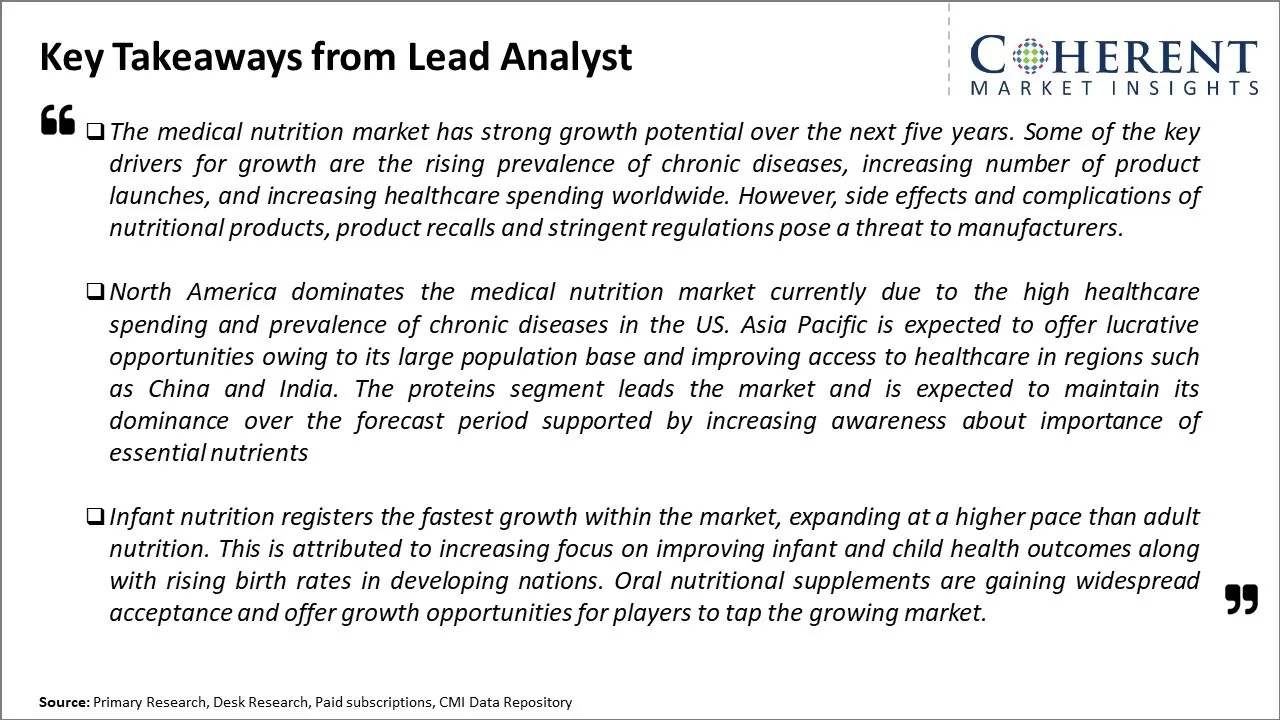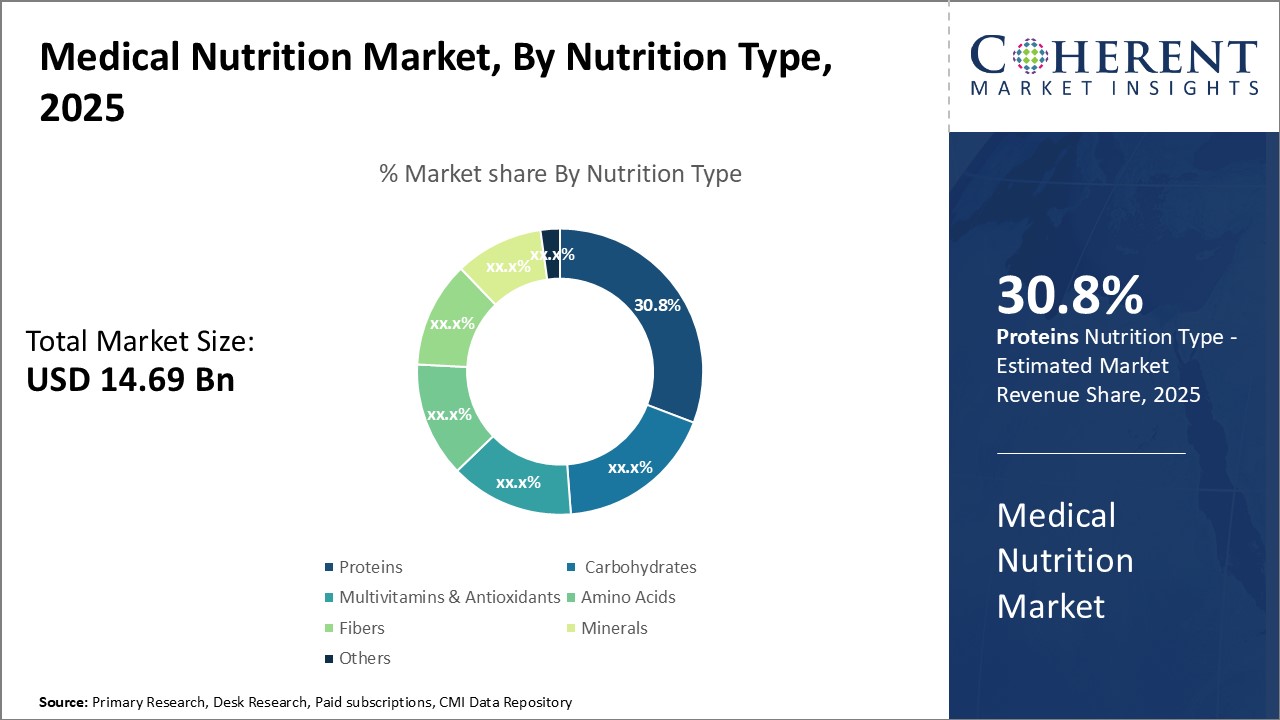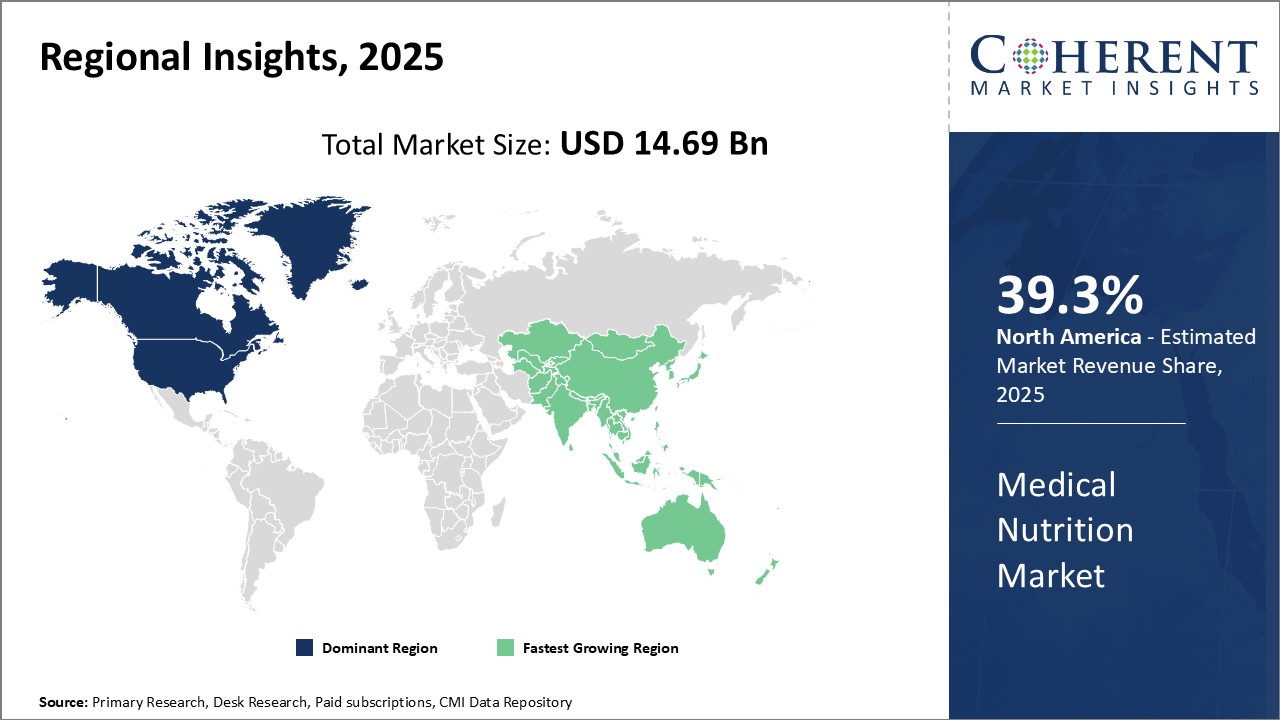The medical nutrition market is estimated to be valued at USD 14.69 Bn in 2025 and is expected to reach USD 21.53 Bn by 2032, exhibiting a compound annual growth rate (CAGR) of 5.6% from 2025 to 2032.

Discover market dynamics shaping the industry: Request sample copy
The medical nutrition market is expected to witness steady growth over the forecast period. Increasing awareness regarding nutrition for improved health and increasing product launches are expected to boost the demand for medical nutrition. Additionally, the rising geriatric population which is more prone to chronic diseases will drive the need for nutritional support and medical nutrition products. The market is also witnessing increased demand for products tailored to specific medical conditions and diseases which is expected to shape the trend.
Market Driver – Increasing Number of Product Launches
Medical nutrition plays an important role in the management of certain chronic conditions such as diabetes, obesity, constipation, malabsorption, maldigestion, etc. It also helps to maintain healthy lifestyle, improves appetite and food intake, lowers the risk for nutrient deficiencies and other health conditions. Medical nutrition is recommended for patients of all ages including infants, adults, and geriatrics who are susceptible to conditions such as diabetes, obesity, renal failures, chronic diseases, neurological diseases, and others. These factors have led to an increase in demand for medical nutrition. Various manufacturers are engaged in the development and launch of innovative and novel medical nutrition products, which is expected to drive the growth of the global medical nutrition market. For instance, on January 25, 2023, Nutricia, a subsidiary of Danone, a multinational food-products corporation, announced the launch of Fortimel, which is a plant-based oral nutritional supplement made from pea and soy protein, which is meant to meet the dietary needs of malnourished patients and those at risk of becoming malnourished.

Get actionable strategies to beat competition: Request sample copy
Market Driver – Rising Prevalence of Chronic DiseasesThe prevalence of chronic diseases has been steadily increasing over the past few decades. Chronic diseases such as diabetes, cancer, cardiac, digestive disorders etc., have become quite common. A major reason for this rise is the changing lifestyle and dietary habits of people. People are consuming more processed and fried foods which are high in fat, salt, and sugar. They are also becoming less physically active due to more sedentary jobs and dependency on automobiles for mobility. This changing disease profile has increased the demand for specialized medical nutrition products. For instance, according to a report published in Center for disease control and prevention on October 14, 2022, around 697,000 people in the U.S. died from heart disease in 2020, whereas around 20.1 million adults age 20 and older had Coronary Artery Disease (CAD) in the U.S. in 2020. As these chronic diseases require lifelong management and control of symptoms, patients need consistent dietary interventions through formulated food products. The rising healthcare costs of chronic diseases have also directed more focus on preventive measures including medical nutrition therapy. Various awareness programs highlight the role of nutrition in chronic disease management. This is driving more patients and physicians to recommend structured medical nutrition plans.

To learn more about this report, Request sample copy
Market Challenges – Side Effects and Complications of Nutritional ProductsThe major factors restraining the growth of the medical nutrition market are side effects and complications caused by products indicated for medical nutrition, if consumed in excess. Excess consumption of any nutritional product can lead to life threating conditions. For example, parenteral nutritional therapy can lead to serious and life threating conditions such as refeeding syndrome or liver dysfunction. According to data published in the Journal of Gastroenterology and Hepatology in May 2022, in New Zealand, around 50% patients receiving parenteral therapy were at risk of developing the refeeding syndrome, and around 14% actually developed it in 2020.
Market Opportunities – Focus on Potential Emerging Markets
Key players in the global medical nutrition market are focused on entering potential untapped markets in emerging economies such as India and China, where the prevalence of nutritional deficiency is high. For instance, according to data published by the National Center for Biotechnology Information, in December 2021, the prevalence of malnutrition people in India was found to be around 35.8%- 45% in 2020.

Discover high revenue pocket segments and roadmap to it: Request sample copy
Insights, By Nutrition Type: Increasing Awareness about Importance of Essential NutrientsThe nutrition type segment includes proteins, carbohydrates, multivitamins & antioxidants, amino acids, fibers, minerals, and others. The proteins subsegment is expected to have 30.8% of the market share in 2025 owing to the increasing awareness about the importance of essential nutrients for daily functioning. Proteins are one of the most crucial macronutrients required by the body to build muscles, organs, skin, and blood. They also help in transporting nutrients, regulating body processes, and strengthening immunity. With growing health consciousness, people are recognizing the need to supplement their diet with high-quality protein sources to meet the body’s needs. This has fueled the demand for medical nutrition products rich in proteins. Furthermore, protein requirements are heightened for patients suffering from chronic diseases, elderly population, and athletes. Hence, the protein segment dominates the medical nutrition market. Increasing growth strategies such as acquisitions by the key market players are expected to drive the segment growth over the forecast period. For instance, in February 2022, Nestlé Health Science, is a nutrition, health and wellness company, announced that the company has completed the acquisition of Vital Proteins, a U.S.-based collagen provider, and a lifestyle and wellness platform that offers supplements, beverages, and food products.
Insights, By Indication: Management of Diabetes through Customized Therapies
The indication segment includes diabetes, cancer, gastrointestinal diseases, metabolic syndromes, and others. The diabetes subsegment is expected to have 35.8% of the market share in 2025 due to the growing prevalence of the disease and the need for personalized care plans. Diabetes has become one of the most common lifestyle disorders affecting people globally. Medical nutrition therapy plays a pivotal role in effective diabetes management by controlling blood sugar levels and moderating energy intake. The options available under the diabetes segment cater to different glycemic index requirements, making nutrition an integral part of diabetes self-care. This allows patients to achieve optimal blood glucose control through customized nutrition-based regimens. Thus, the large diabetic population relies greatly on the specialized nutrition products, driving the growth of this segment.
Insights, End User: Expanding Role of Nutrition in Hospitals
The end user segment includes hospitals, home care settings, long term care, and ambulatory surgical centers. The hospitals subsegment is expected to have 38.7% of the market share in 2025 owing to the centralization of healthcare services. As hospitals are increasingly acknowledging the importance of clinical nutrition in patient care, many are establishing dedicated nutrition support teams and specialized departments. This expanding role has elevated the demand for therapeutic nutrition from hospitals. For critically ill patients who are unable to meet their nutritional needs through oral intake, intravenous nutrition is often prescribed and administered under medical supervision in hospitals. Furthermore, pre and post-surgery nutritional counseling and support are commonly provided during hospital visits. Hence, with growing healthcare infrastructure and uptake of evidence-based practices worldwide, the hospital segment dominates medical nutrition usage.

Need a Different Region or Segment? Customize now
North America remains the dominant region in the global medical nutrition market and is anticipated to hold 39.3% of the market share in 2025. The presence of leading global players and established healthcare infrastructure have propelled the market growth. The U.S. accounts for the major share due to high healthcare spending and awareness levels among consumers regarding nutritional interventions for clinical conditions. Several initiatives by regulatory authorities to enhance quality standards along with private-public partnerships for innovation in formulations have strengthened the market position. However, pricing pressures due to frequent reimbursement changes and preference towards consumer-centric products pose challenges.
The Asia Pacific region is poised to exhibit the highest growth fueled by increasing healthcare expenditures, growing middle-class population, and awareness regarding prevention through nutrition. China and India represent the hotspots owing to rising instances of metabolic disorders and expanding medical coverage in rural areas. Healthcare reforms focusing on malnutrition and integration of traditional expertise with evidence-based guidelines are aiding growth. Localization of products is gaining traction as consumers demand affordable options customized to tastes and ease of use. Export growth to western nations also indicate scope for leveraging the cost advantages.
Medical Nutrition Market Report Coverage
| Report Coverage | Details | ||
|---|---|---|---|
| Base Year: | 2024 | Market Size in 2025: | USD 14.69 Bn |
| Historical Data for: | 2020 To 2024 | Forecast Period: | 2025 To 2032 |
| Forecast Period 2025 to 2032 CAGR: | 5.6% | 2032 Value Projection: | USD 21.53 Bn |
| Geographies covered: |
|
||
| Segments covered: |
|
||
| Companies covered: |
Abbott, Danone S.A., Baxter, Nestlé, GSK plc., Sun Pharmaceutical Industries Ltd., Sanofi, DSM, BASF SE, Fresenius SE & Co. KGaA, Leprino Foods Company, Fresenius Kabi Ltd, Esperer Onco Nutrition, Kate Farms, and Guardion Health Sciences, Inc. |
||
| Growth Drivers: |
|
||
| Restraints & Challenges: |
|
||
Uncover macros and micros vetted on 75+ parameters: Get instant access to report
*Definition: The medical nutrition market includes products like supplemental nutrition, food for special medical purposes, and clinical nutrition. These are specially formulated nutritional products used in the clinical management and treatment of patients suffering from chronic diseases or health conditions like diabetes, cancer, malnutrition, gastrointestinal disorders, pulmonary diseases, and others. Medical nutrition helps meet the specialized nutritional needs of patients through the use of supplements, enteral feeding, and parenteral nutrition.
Share
Share
About Author
Ghanshyam Shrivastava - With over 20 years of experience in the management consulting and research, Ghanshyam Shrivastava serves as a Principal Consultant, bringing extensive expertise in biologics and biosimilars. His primary expertise lies in areas such as market entry and expansion strategy, competitive intelligence, and strategic transformation across diversified portfolio of various drugs used for different therapeutic category and APIs. He excels at identifying key challenges faced by clients and providing robust solutions to enhance their strategic decision-making capabilities. His comprehensive understanding of the market ensures valuable contributions to research reports and business decisions.
Ghanshyam is a sought-after speaker at industry conferences and contributes to various publications on pharma industry.
Missing comfort of reading report in your local language? Find your preferred language :
Transform your Strategy with Exclusive Trending Reports :
Frequently Asked Questions
Joining thousands of companies around the world committed to making the Excellent Business Solutions.
View All Our Clients
US Reciprocal Tax Impact Analysis On Medical Nutrition Market
Stay updated on tariff changes with expert insights and timely information